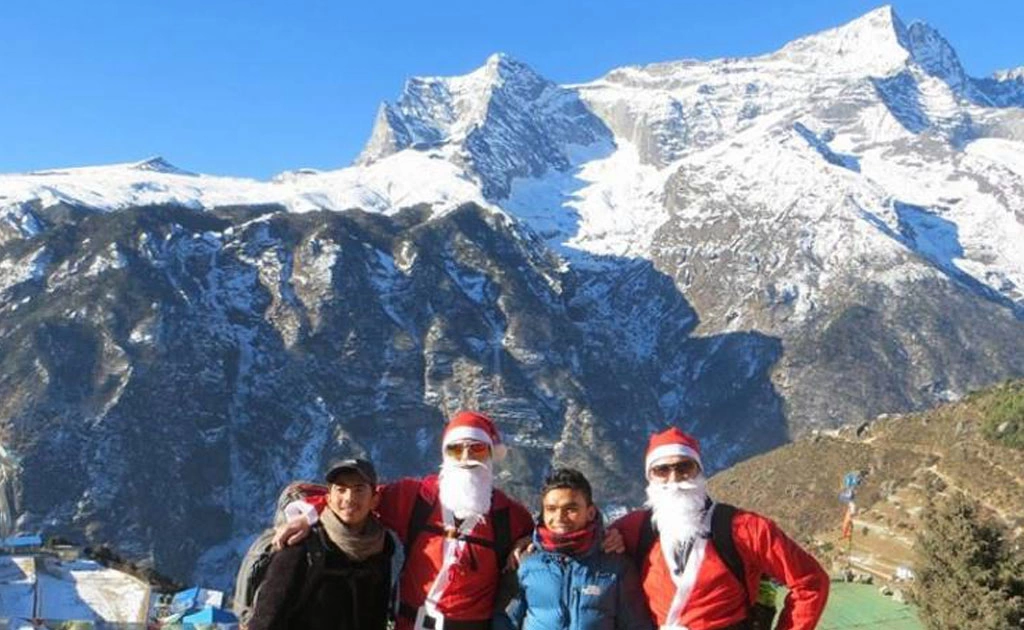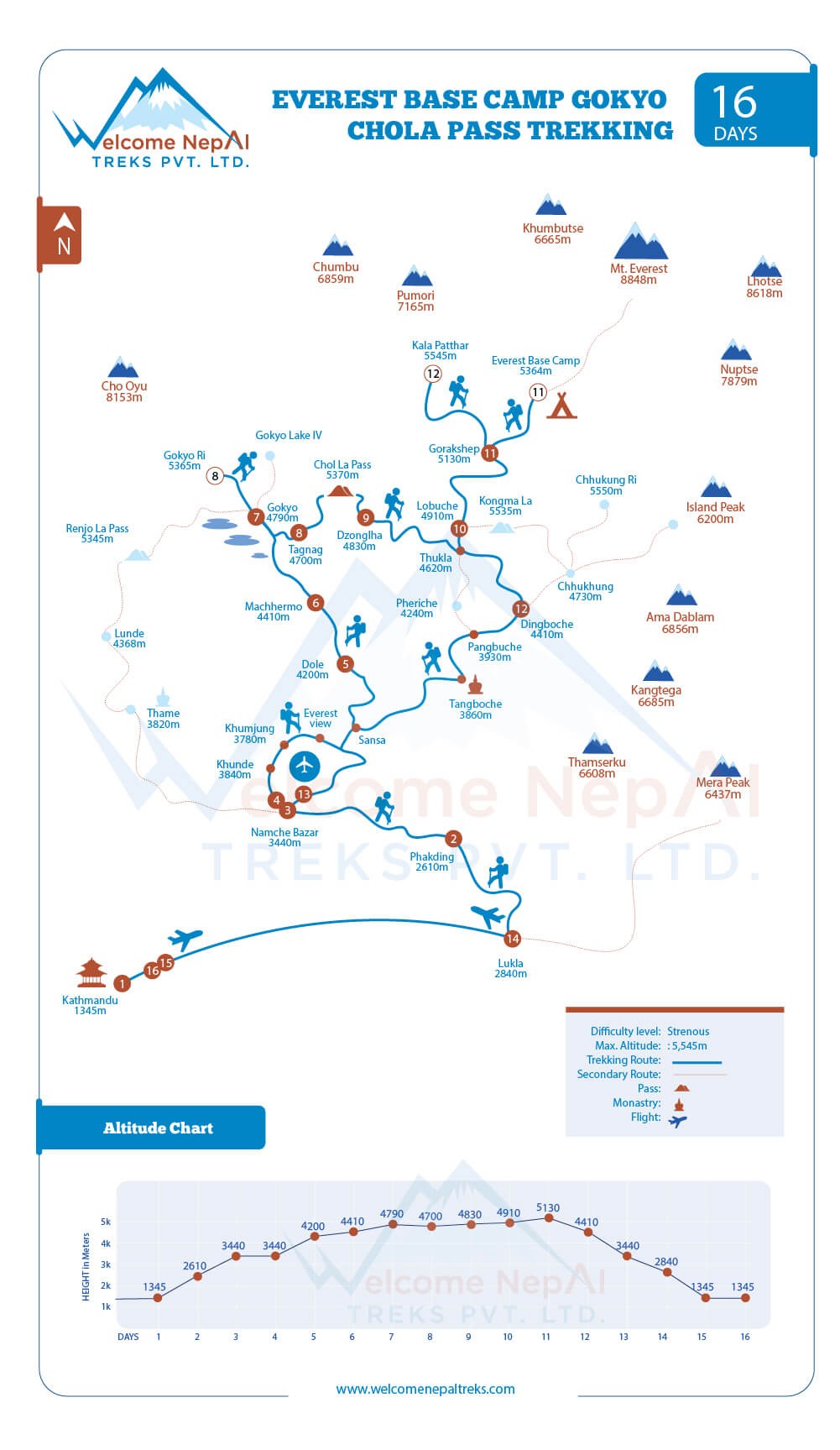Everest Base Camp Trek via Gokyo Lakes and Cho La Pass
We specialists in organizing Everest Base Camp Trek via Gokyo Lakes and Cho La Pass holidays. Spectacular views are waiting for you in Gokyo Chola Pass Trekking! Everest Base Camp Trek via Gokyo Lakes and Cho La Pass is world famous walking holidays. Gokyo Chola Pass Trek is most popular trekking trail of Everest region. Gokyo Chola Pass Trek is the ideal destination for tourism in Nepal. Gokyo Chola Pass Trekking is one of our popular adventure holidays. We offer special rates with best service on your Gokyo Chola Pass Trekking.
Khumbu region is considered as one of well-known areas for trekking in the world. Thousands of visitors pay their visit annually in this marvelous region. The inhabitants of the region are the legendary Sherpas. These hardy people have carved an existence since time immemorial from the frozen landscape. Deep in the Himalaya, in a quite remote valley, are the magnificent azure blue Gokyo Lakes. The series of glacial lakes are set in beautiful high altitude wilderness dominated by the great peaks of Cho Oyu, (8153m.) and Gyachungkang (7922m.). Quite less well-known than the main Everest trail, a trek in this valley provides stunning views of many Himalayan giants. This high altitude trek explores the heart of the Sherpa homeland, visiting Namche Bazaar,and Tyangboche before ascending to our destination.
Justifiably acknowledged as one of Nepal's most famous treks to the Khumbu Mountains & Sherpa settlements, the trek offers a unique experience to the visitors. The trail to Gokyo and Chola Pass is a gradual ascent up the valley passing through patches of birch and rhododendron forest where the elusive musk deer can sometimes be seen. Through small yak-grazing settlements we reach the Gokyo Lakes where we ascend the Gokyo Peak (5480m) and enjoy stunning mountains summit views including Everest, Makalu and Cho Oyo.
Visiting the Cho La pass, we reach Dzongla. The views of Ama Dablam and Taweche look spectacular from here. Ascending Zhongla, we continue towards Gorak Shep and climb to Kala Pattar (5545m) from where we enjoy an impressive close-up view of Everest. Our return route passes through Tengboche monastery, where we rest and savor the incredible scenery, including magnificent views of Everest, Ama Dablam (6856m), Kantega (6809m), Kwangde (6194m), Nuptse (7879m) and Lhotse (8511m)
Everest Base Camp Trek via Gokyo Lakes and Cho La Pass in spring season
Spring is an ideal time for Everest Base camp Trek via Gokyo lakes and Cho La Pass. Spring which spans form March-May offers the perfect weather condition with mild temperature ranging from 1 to 13° Celsius and clear skies. The trails in spring looks mesmerizing with vibrant colors of new blooming flowers and rhododendrons. Get a majestic view of the breathtaking mountains due to high and clear visibility in spring. Therefore, spring is considered as the great time to undertake Everest Base Camp trek via Gokyo lakes and Cho La Pass.
Everest Base Camp Trek Via Gokyo Lake and Cho La Pass in monsoon season
Monsoon (June-Aug) is not a great time for the Everest Base Camp Trek Via Gokyo Lakes and Cho La Pass. Due to the frequent rainfall and unpredictable weather conditions the trek becomes challenging in this season. The temperature in this season is hot than other time of the year. Trekkers experiences warm, wet and humid weather in monsoon. The trekking trails are peaceful with less trekkers. the paths are usually slippery which cause risks in the trek. The flights may get delayed or canceled due to bas weather condition which makes the trip less enjoyable. Overall, monsoon is not a good time to do the Everest trek via Gokyo lake and Cho La Pass.
Everest Base Camp Trek via Gokyo Lakes and Cho La Pass in autumn season
Autumn is considered the best season for the trekking in Everest via Gokyo lake and Cho La Pass. The temperature during this season is neither too hot nor too cold. Autumn season spanning from Sept- Nov attracts the trekkers with favorable weather conditions and breathtaking vistas. The trekking routes and the teahouses are mostly crowded in this season. You can interact and connect with the trekkers and share the experiences. Overall, autumn season exciting and unforgettable adventure in Everest.
Everest Base Camp Trek via Gokyo Lakes and Cho La Pass in winter season
Winter season is not much recommended for Everest base camp trek via Gokyo lakes and Cho La Pass. The season brings risks while trekking with harsh weather. Winter is the coldest season with the temperature dropping up to -17°C and even lower at the high passes. The heavy snowfalls in the region block the paths which makes the trekking difficult. The harsh weather might cause frostbite, dry skin, and irritation during the hike. So, it is highly recommended for trekkers to wear good layer of clothing. overall winter is not the best time to trek to Everest via Gokyo lake and Cho La Pass.
Packing Lists for Everest Base Camp Trek via Gokyo Lakes and Cho La Pass
Trekkers are suggested to be well prepared and pack the right equipment for the Everest Base Camp trek via Gokyo lake and Cho La Pass. Here are the packing lists of necessary equipment to pack in these 16 days long trek:
- T-shirt, sweaters, waterproof jacket, down jacket
- Trekking boots, warm socks and inner wears
- Sun hat, sunscreen cream, face wipes, lip balm, sunglasses
- Headlight, water bottles, power banks
- Gloves, scarf, quick drying towel
- Backpack, trekking pole, water purification tablets, sleeping bags
- Money, Cell phone, Camera,
- Necessary documents
- First aid kit
Beside these you can bring other useful equipment to maintain hygiene and cleanliness like: tissues nail clippers, soap, moisturizers, camera, sanitary pads, sanitizer and other personal accessories. Do not over pack as it will be difficult on the trek.
Benefits of doing Everest Base Camp Trek via Gokyo Lakes and Cho La Pass with welcome Nepal Treks
- Welcome Nepal Treks offer the trekking package at the reasonable price with high quality and best hospitality.
- Arrangement of Trekking permits for the Everest Base Camp Trek via Gokyo lake and Cho La Pass
- Free Pick up and drop from Airport-Hotel-Airport
- Arrangement of accommodation in teahouse lodges during the trek
- Standard meals (Breakfast, Lunch and Dinner) during the trek.
- We arrange some necessary trekking equipment like sleeping bags, Down jackets, trekking pole, etc. if you haven’t brought your own.
- Professional, well trained and friendly trekking guide provided
- Our team organize the Everest base camp trekking with full safety and security.

